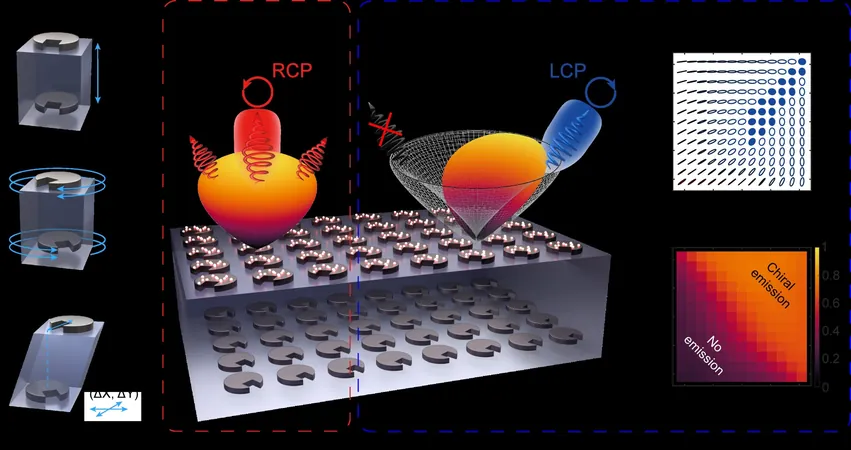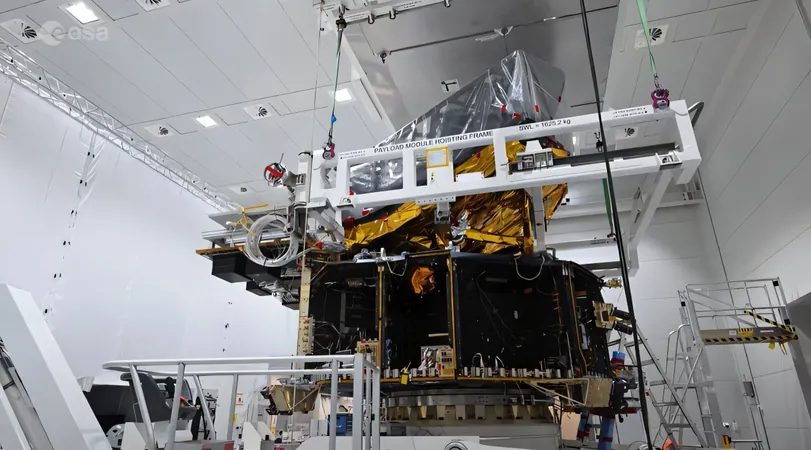
Revolutionary Spiral Ladder Design Unlocks Precision Control of Light Direction and Polarization!
2024-11-14
Author: Charlotte
Introduction
In a groundbreaking study, researchers at the Singapore University of Technology and Design (SUTD) have developed an innovative tool inspired by the elegant geometry of spiral ladders. This revolutionary device allows unprecedented precision in controlling light direction and polarization—a feat that could have significant implications in various fields including quantum computing, optical communications, and advanced sensing technologies.
Understanding Polarization in Photonics
Photonics, the science behind the generation and manipulation of light, often grapples with the intricate properties of light waves, among which polarization plays a crucial role. Polarization describes the orientation of the electric and magnetic fields of light waves, which can oscillate in a myriad of ways. When it comes to turning light waves into useful resources, circular polarization, where light follows a spiral path, stands out for its potential applications.
Challenges in Controlling Circularly Polarized Light
Despite its promise, achieving effective control of circularly polarized light has posed a difficult challenge. "Directing circularly polarized light at specific angles is essential for optimized collection and usage," said Dr. Wu Lin, an Associate Professor at SUTD. Traditional light sources, like quantum dots—tiny semiconductor nanocrystals—emit light in all directions with limited polarization. However, placing these quantum dots next to specially designed nanostructures can direct their output and enhance polarization.
Innovative Design of Twisted Bilayer Metasurfaces
In their recent paper published in *Nature Communications*, Dr. Wu's team tackled this dual-faceted challenge head-on. They introduced their ingenious 'twisted bilayer metasurfaces' designed as layers of disks with precisely arranged notches. This unique structure breaks mirror symmetry, enabling it to emit chiral waves—waves whose mirror images cannot be superimposed.
Significance of Bilayer Structure
What makes this discovery particularly revolutionary is the bilayer component. By allowing independent control of each layer before coupling them together, the design provides exceptional flexibility. As Ph.D. student Dmitrii Gromyko—the first co-author of the paper—explained, "Climbing just two steps of our ladder provides crucial insight into whether you're following a clockwise or counterclockwise path." This clarity in design extends to the manipulation of light properties, crucial for applications ranging from medical imaging to secure communication technologies.
Precision in Fabrication
The team's innovative construction allowed them to manipulate key parameters: the space between layers, the alignment of notches, and the positional adjustments of the top disks. Undertaking such precision—aligning layers to within 10 nanometers—was no small feat and showcased the advanced fabrication capabilities available in Singapore, thanks to collaborations with local research institutions.
Future Implications and Applications
The implications of these findings are vast. The team envisions the use of their nanostructures for various applications including efficient light routers and emitters that can tailor light emission to suit specific needs. Building on this success, the next phase involves integrating their bilayer design with nano-electro-mechanical systems, paving the way for reconfigurable metasurfaces capable of dynamically adjusting light parameters.
Conclusion
With this pioneering work, Dr. Wu and her colleagues not only advance photonics as a field but also align with cutting-edge practices that meet the demands of modern technology. "We are driven by the challenges and the practical problems we can solve through smart design innovations," she remarked, emphasizing the importance of continued advancement in this realm.
Looking Ahead
As technology rushes forward, embracing the power of light in new and transformative ways, this research marks a striking step toward the future of integrated photonic devices. The electrical and optical engineering community is keeping a close eye on this groundbreaking development, as its repercussions will likely ripple across sectors, from healthcare solutions to next-generation communication networks. Stay tuned for more updates as the team continues to push the envelope of what is possible in the fascinating world of light manipulation!









 Brasil (PT)
Brasil (PT)
 Canada (EN)
Canada (EN)
 Chile (ES)
Chile (ES)
 Česko (CS)
Česko (CS)
 대한민국 (KO)
대한민국 (KO)
 España (ES)
España (ES)
 France (FR)
France (FR)
 Hong Kong (EN)
Hong Kong (EN)
 Italia (IT)
Italia (IT)
 日本 (JA)
日本 (JA)
 Magyarország (HU)
Magyarország (HU)
 Norge (NO)
Norge (NO)
 Polska (PL)
Polska (PL)
 Schweiz (DE)
Schweiz (DE)
 Singapore (EN)
Singapore (EN)
 Sverige (SV)
Sverige (SV)
 Suomi (FI)
Suomi (FI)
 Türkiye (TR)
Türkiye (TR)
 الإمارات العربية المتحدة (AR)
الإمارات العربية المتحدة (AR)